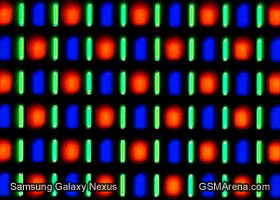Google Nexus 4 review: Royal road
Royal road
Display
The LG Nexus 4 features a 4.7" True HD-IPS+ LCD screen of 768 x 1280 resolution and 608 nits of brightness. There's about 8% more screen real estate than on the Samsung Galaxy Nexus, the extra surface mostly due to the display being wider.
While the pixel density is virtually the same - just under 320ppi - the display on the Nexus 4 is actually sharper due to its RGB matrix, compared to its predecessor and its PenTile Super AMOLED display. Things become clearer once we have both under a microscope.


Google Nexus 4 • Samsung Galaxy Nexus
LG uses a screen technology called Zerogap touch - it's basically a laminated screen so there's no air between the screen layers (which causes glare) and it uses in-cell touch technology. The top layer is Gorilla Glass 2 for protection.
We put the LG Nexus 4 through our usual display tests and here's how it scored. You can find more about the testing procedures here.
The LCD is noticeably brighter than the Galaxy Nexus Super AMOLED screen and even the new Samsung Galaxy S III, though not quite as bright as the HTC One X. The black levels are not that deep though, especially when looking the screen at an angle.
| Display test | 50% brightness | 100% brightness | ||||
| Black, cd/m2 | White, cd/m2 | Black, cd/m2 | White, cd/m2 | |||
| Nokia Lumia 820 | 0 | 260 | ∞ | 0 | 422 | ∞ |
| Nokia Lumia 920 | - | - | - | 0.48 | 513 | 1065 |
| Nexus 4 | 0.22 | 314 | 1447 | 0.45 | 608 | 1341 |
| LG Optimus G | 0.14 | 197 | 1445 | 0.33 | 417 | 1438 |
| HTC Windows Phone 8X | 0.17 | 174 | 1017 | 0.49 | 501 | 1020 |
| Samsung Ativ S | 0 | 129 | ∞ | 0 | 302 | ∞ |
| Nokia Lumia 900 | 0 | 347 | ∞ | 0 | 425 | ∞ |
| Samsung I9300 Galaxy S III | 0 | 174 | ∞ | 0 | 330 | ∞ |
| Apple iPhone 5 | 0.13 | 200 | 1490 | 0.48 | 640 | 1320 |
Sadly, the high reflectivity of the Nexus 4 screen leads to a rather mediocre sunlight performance. The Nexus 4 screen is slightly more reflective than that of the Optimus G, possibly due to the different glass. There's only a slight improvement here over the Optimus 4X HD's display.
Contrast ratio
-
Nokia 808 PureView
4.698 -
Apple iPhone 5
3.997 -
Samsung I9300 Galaxy S III
3.419 -
Samsung Omnia W
3.301 -
Samsung Galaxy S
3.155 -
Samsung Ativ S
3.129 -
Nokia N9
3.069 -
Samsung Galaxy Note
2.970 -
Samsung Galaxy Premier
2.958 -
HTC One S
2.901 -
Samsung Galaxy S II
2.832 -
Huawei Ascend P1
2.655 -
Nokia Lumia 900
2.562 -
Apple iPhone 4S
2.269 -
Nokia Lumia 820
2.193 -
HTC One X
2.158 -
Nokia N8
2.144 -
Nokia Lumia 920
2.107 -
Apple iPhone 4
2.016 -
Sony Ericsson Xperia ray
1.955 -
Nexus 4
1.926 -
HTC Desire X
1.878 -
HTC Windows Phone 8X
1.873 -
Sony Xperia U
1.758 -
LG Optimus G
1.753 -
LG Optimus 4X HD
1.691 -
HTC One V
1.685 -
LG Optimus Vu
1.680 -
HTC Desire V
1.646 -
LG Optimus 3D
1.542 -
Nokia Asha 302
1.537 -
Nokia Lumia 610
1.432 -
Gigabyte GSmart G1355
1.361 -
Sony Xperia miro
1.324 -
HTC Desire C
1.300 -
LG Optimus L7
1.269 -
Meizu MX
1.221 -
Samsung Galaxy Pocket
1.180 -
Sony Xperia tipo
1.166 -
Samsung Galaxy mini 2
1.114
The viewing angles are good thanks to the IPS+ tech, but not without some color and contrast loss.
The software that handles the drawing to the screen is noticeably different between the Optimus G and the Nexus 4. On the Optimus, images get their saturation boosted and are sharpened. The result is more visible detail than on the Nexus. The color balance is also different and it seemed to us that it's more accurate on the Optimus G. We compared images both with the native gallery and the Chrome browser, and the results were the same (so it's not LG's custom gallery enhancing the images).
Handling
The LG Nexus 4 is about the same size as the other Android flagships and offers solid build quality. We do worry a bit that the glass on the back might crack if you drop the phone, though it should be much easier to replace than the front glass, even if the back cover isn't technically user-removable.
Drops aside, the double Gorilla Glass protection that the phone enjoys should keep scratches to a minimum (though we actually managed to get ours scratched). The feel of the material isn't up to par with some metal and polycarbonate unibodies but it's way better than the plasticky Galaxy Nexus. We're talking about a $300 phone after all and it does have a more premium feel than its price tag suggests.
The thin bezel on the left and right of the screen make the phone relatively narrow (especially when you consider it's a 15:9 screen vs. the 16:9 screens of the Galaxy Nexus, Galaxy S III and One X). The handset feels good in the hand, though we would have liked more tapered edges.
Reader comments
- james
- 05 May 2024
- Sq6
Upgradable to Android 5.1 (Lolipop)
- Anonymous
- 21 Oct 2015
- 3%F
Press power button and volume down button in the same time
- AnonD-403739
- 07 Jun 2015
- H3M
The volume of my ringtone is diminishing down to zero sound. Can anybody advise the likely cause and cure?



